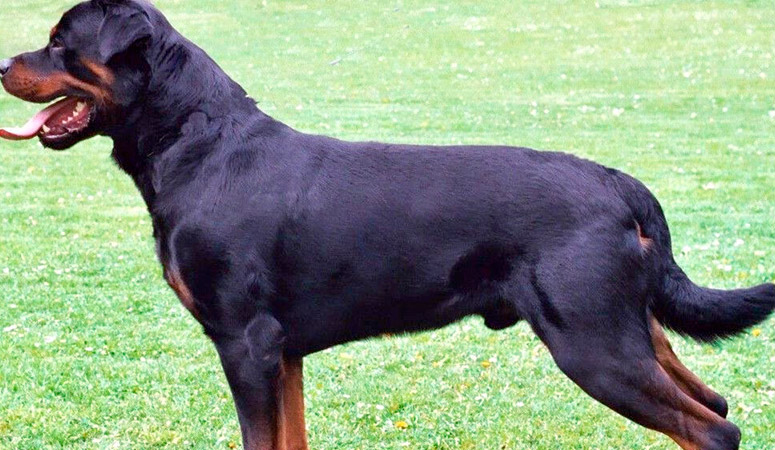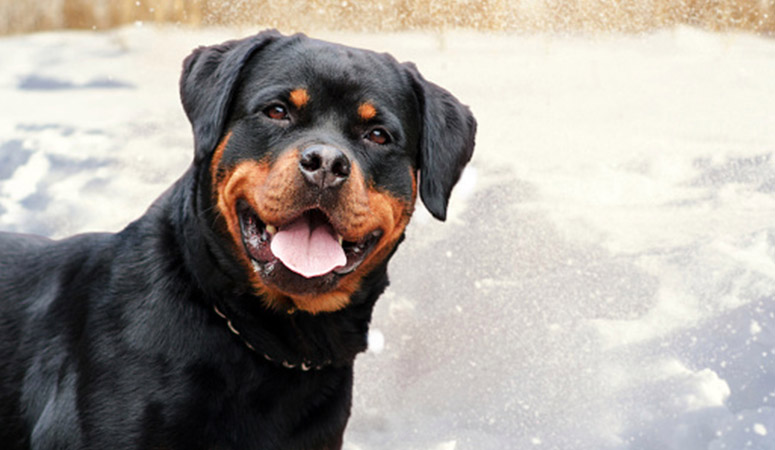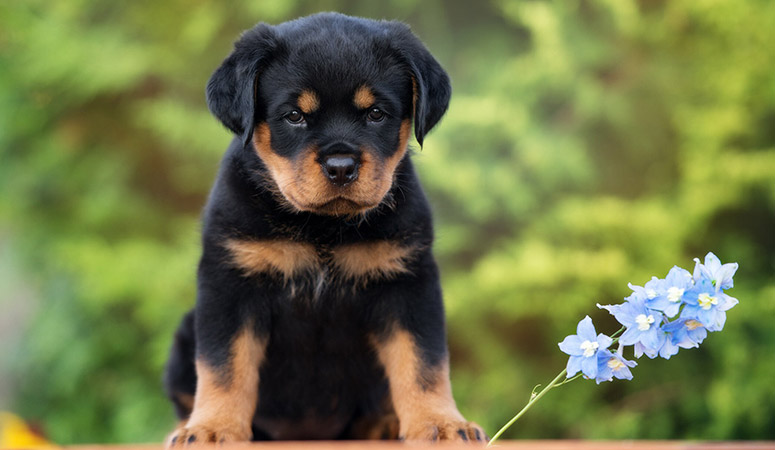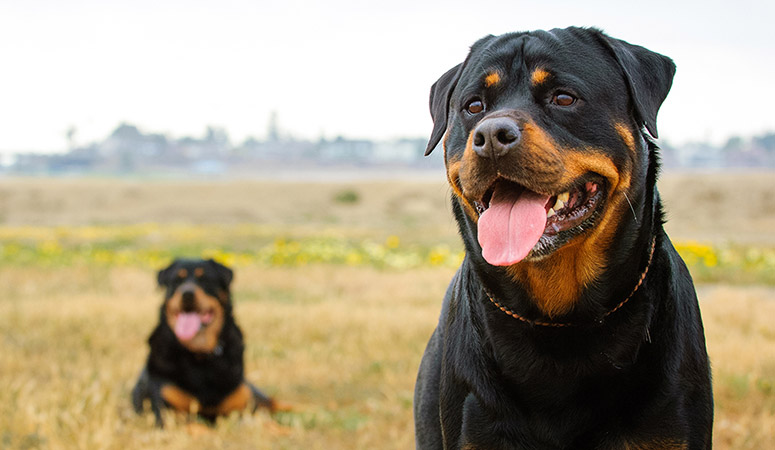Rottweiler

Rottweilers, commonly known as the Rotti, are loyal, intelligent, loving, calm, courageous, and confident guardian characterized by mesaticephalic skulls, oval or almond-shaped eyes, black wide noses, medium-sized triangular ears, well-muscled necks, robust bodies, and medium length tails. As one of the oldest herding dog breeds, it is said that Rottweilers are descended from Roman drover dogs, which are mastiff-type dogs used by the Romans to herd livestock to other countries. Nowadays, Rottweilers are often trained as search-and-rescue dogs and they have done great jobs in some of the world’s most significant disasters including Oklahoma City bombing in 1995, September 11 attacks in 2001, Hurricane Katrina in 2005, and Haiti earthquake in 2010.
| Other Names | Rottweil MetzGerhund |
| Color | Black and tan or black and mahogany |
| Height | Males: 24-27 inches. Females: 22-25 inches. |
| Weight | Males: 95-110 pounds. Females: 90-105 pounds. |
| Life Span | 9-10 years |
| Personality | Even-tempered, Watchful, Extremely intelligent |
| Exercise | Regular Exercise |
| Origin |
| Popularity | #8 |
| Groom Needs | Weekly Brushing, Seasonal Shedding |
| Kids Friendly | Yes with supervision |
| Dog Friendly | Yes with supervision |
| Watch Dog | Yes |
| Family Dog | |
| Litter Size | Average 8 to 12 |
Rottweiler Pictures
Rottweiler Video
Introduction
The Rottweiler is a distinct breed of domestic dogs that are widely believed to have originated in Germany as descendants of the Roman breed of mastiffs. With a short black coat flecked with tan or mahogany, a Rottweiler may appear terrifying and fierce even before you know the first thing about them. However, the truth about this breed is that they could be very playful around their family, fond of their favorite people, and yet aggressive and vicious towards outsiders. Until the mid-19th century, Rottweilers were used as herd dogs and also for pulling carts of livestock to the market for sale. Little wonder the Germans named them Rottweil Metzgerhund which meant “Butcher’s Dogs”.
They are a robust figure in flesh and muscle — an average male can stand to an impressive shoulder height of between 24 and 27 inches while a similar female would measure only about 2 or 3 inches below that. In their youth, Rottweilers can be powerfully thickset, weighing close to 110 pounds for males or 105 pounds for well-fed females. They can possibly live up to 9 years before they eventually die of old age.
Living with Rottweiler
With a coarse, straight, medium-length coat that lies flat short, the smooth-coated breed only needs a weekly brush and regular bath to maintain healthy skin and a shiny coat. Because Rottweilers are short-haired dogs, it is suggested to use a soft rubber curry brush to scrub away loose hairs, dirt, dust, dander, tangles, and mats from the coats. In addition, curry brush with soft rubber teeth could also massage dog skin and help blood circulation. Keep in mind to flick your wrist up while brushing to prevent dog fluff falling across the floor.
Rottweiler’s teeth should be brushed once a week. Squeeze dog toothpaste on a dog toothbrush and gently brush the front, side, and back teeth on the top and bottom. Never use human toothpaste on your dog as most human toothpaste contains an artificial sweetener called Xylitol, which is extremely poisonous to dogs.
Rottweiler’s nails should be trimmed on a weekly basis. Hold your Rottweiler’s paw steady in your hand and trim off only the tip of the toenail with a guillotine or scissors-type clippers. Watch carefully while clipping as Rottweilers have black nails, which make it difficult to see define the cutting range.
According to the Kennel Club, Rottweilers require at least 2 hours of exercise daily to stay healthy and in shape. Here are some easy exercise activities you could consider to add to your dog’s routine.
Take a Walk
Walking your Rottweiler is the easiest way to burn off his energy and stimulate his mind with sights and sounds he comes across. Exact walking hours depends on your Rottweiler’s weight, age, size, and health condition and it could vary from one Rottie to another. No matter how much exercise your dog needs, it is highly recommended to evenly split it to two small walks with one in the morning and another one in the evening.
Playing Fetch
Fetch is one of the common dog games and playing fetch with your Rottweiler is a good way to exercise your dog and strengthen your bond. Avoid using sticks for this activity since sticks are sharp and it could ram down the throat and puncture the tongue. Besides, Your Rottweiler might chew on them and swallow muddy splinters, which lead to gruesome infections. It is suggested to choose the safe dog toys such as tennis ball, plastic or rubber bumper, or rope toy as the object to throw.
Since Rottweilers are prone to food allergies, a balanced and hypoallergenic diet is required for this dog breed to avoid vomiting or gas problems and help maintain bowel health. It is suggested to feed 22-26% protein for an adult Rottweiler and 24-28% protein for a puppy. Be careful when choosing pet food for your dog and always read the ingredients listed in the label. Poor-quality dog food contains chemical preservatives including Butylated Hydroxyanisole, Butylated Hydroxytoluene, and Ethoxyquin, which are extremely toxic to Rottweilers. Higher-quality dog food often contains natural preservatives such as tocopherols (vitamin E) and ascorbic acid (vitamin C), which are made from antioxidants and cause no digestive upset.
Progressive retinal atrophy, cataracts, aortic stenosis, elbow dysplasia, osteochondritis dissecans, and allergies are the most common canine health problems that Rottweilers may encounter. Progressive retinal atrophy, also known as PRA, is an inherited disease that damages photoreceptor cells and ultimately leads to blindness. It is difficult to recognize the early symptoms when dog owners are in-adequately educated. Dogs affected by progressive retinal atrophy tend to have night blindness in the beginning and you might notice that your Rottweiler is unwilling to go to dark places or always bumps into things especially in dim light. Make sure to send your dog to your veterinarian for a checkup if you think your Rottie is probably developing progressive retinal atrophy. Some are good at hiding their vision loss and you could easily overlook until you bring your Rotti to see an ophthalmologist. Since there is no effective treatment for PRA, you should be well-prepared and help your dog cope with the new life after vision loss.
Total Annual Cost:
Cost is estimated for the first year and may vary depending on many factors, such as dog food, health care, leash, collar, licensing, possible fencing, crates, training and obedience classes, dog-walking, grooming, treats, toys, flea, tick, and heart-worm meds, microchips, etc.
$4,400
Rottweilers were originally bred to herd, therefore they are a loyal trainable dog breed perfect for working dogs like guard dogs, police dogs, service dogs, and therapy dogs. Rottweilers love to learn and they are happy when given tasks or jobs. Early socialization is critical for healthy development and it prevents your Rotti from being overprotective or aggressive. The followings are several tips to socialize your dog with humans and other dogs.
Dog Parks
Dog parks or pet shops are the best places to let your Rotti play and make friends with other dogs. Most importantly, make it positive and give him a high-value treat if he has a successful interaction.
Dog Classes
Dog classes provided by certified trainers could help your Rotti with early socialization by exposing him to other people and dogs. As dog owners, you could also learn some new skills and commands that keep your dog under control at home or in public.
History
Around the middle of the first century, during the Roman quest to conquer Europe, the legions traveled far into the Alps to settle in a region now known as Southern Germany. They brought their live cattle with them for food as there was no means to preserve or refrigerate meat at the time. Roman drover dogs of the mastiff breed kept wary eyes over the herd.
These drover dogs were still used for herding and trading of livestock, even many years after the Swabians came and drove the Romans out of the region. Soon, this breed of drover dogs was named after the town, Rottweil in Germany.
In the Middle Ages, the Rottweillers were used by itinerant butchers, especially for safeguarding their money purses which were hung around the dog’s neck. Eventually, the breed was known as Rottweil Metzgerhund, literally Rottweil’s Butcher’s Dogs. It wasn’t until the railroads took over the conveyance of livestock to the markets that the demand for Rottweillers began to diminish. But the demand for Rottweillers took an abrupt rise again in the heat of World Wars I and II as they were used as police dogs, or search and rescue dogs, and a host of other purposes.
On January 13, 1914, the first Rottweiller club in Germany, the Deutscher Rottweiler-Klub, was established and a number of other clubs began to spring up a couple of months after. By 1921, these clubs merged to form the Allgemeiner Deutscher Rottweiler Klub. The American Kennel Club first recognized the breed in 1931 before, subsequently, Rottweillers became quite popular and were displayed in many other parts of the world.
Helpful Information
Breed Club: AMERICAN ROTTWEILER CLUB
Breed Club Link: http://www.amrottclub.org/
Breed Club Rescue: THE ROTTWEILER RESCUE FOUNDATION
Breed Club Rescue Link: http://rottweilerrescuefoundation.org/




